Pomegranate Insect Pests
Pomegranate Insect Pests
Anar butterfly/ Pomegranate fruit borer
Biology:
- Eggs: Laid singly on tender leaves, stalks and flower buds.
- Larvae - Bark brown, short and stout, covered with short hairs, larval period lasts for 18-47 days.
- Pupation: Occurs either inside the damaged fruits or on the stalk holding it. Pupal period lasts for 7-34 days. Total life cycle is completed in 1 to 2 months.
- Adult - Bluish brown butterfly.
Damage symptoms:
- Caterpillar bores into young fruits.
- Feeds on internal contents (pulp and seeds)
- Fruit rotting and dropping may occur

Favourable conditions:
- It is mostly prevalent during the 'mrig' bahar.
- Fruit injury revealed at the age of 30—50 days.
Life cycle:
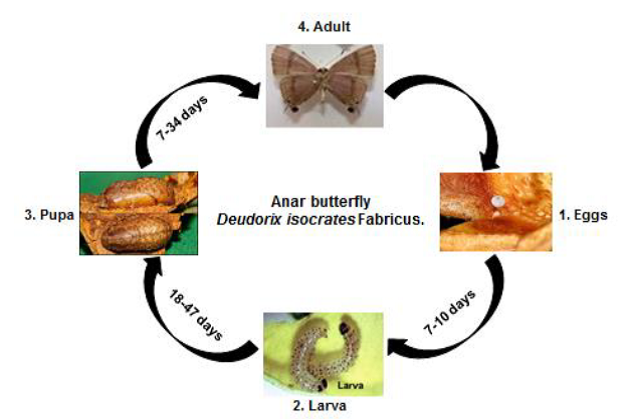
Stem borer
Biology
- Egg: Eggs are laid in young living plants in stems and is deposited under the bark. The number of eggs laid by female is 20-40
- Grub: Newly emerged larva is about 1/4 of an inch long the mature larva is about 2.1/2 inches long. On hatching the larva feeds on the soft tissues around the oviposition cavity and then bores into the stem and roots. The length of the larval period is about nine or ten month.
- Pupal: Period is16 to 18 days. There is only one generation per year and longevity of beetles is 45 to 60 days.
- Adult: Pale yellowish-brown body with light grey elytra and are 30 to 35 mm long. The beetle emerges by eating a circular hole through the bark. Adult beetles are 1.1/4 to 1.1/2 inches long, dull, yellowishbrown, the sides of the body and legs bluish, elytra yellowish-grey with a large number of black spots varying in size from a pin's head to minute specks.
Damage symptoms:
- The grubs bore inside the trunk and feed on sapwood.
- Adult beetles are active by the day and feed by gnawing the green bark of shoots.
- Holes on bark of main stems, excreta and dry powdered material are usually seen near the base of plants.
Life cycle:
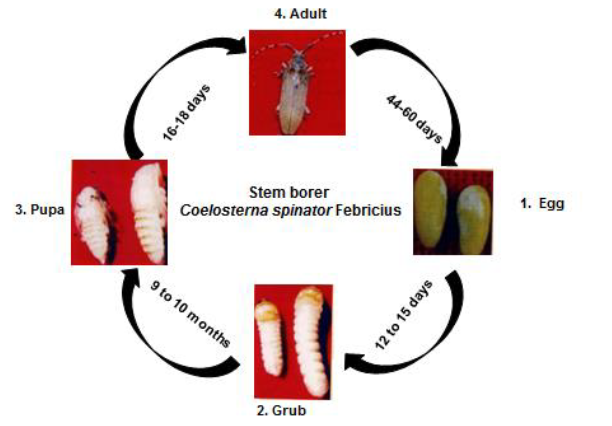
Natural enemies of stem borer:
Predators: Damsel bugs, elm leaf beetle, spiders, tachinid flies, big eyed bugs (Geocoris sp.), braconid wasp
Whitefly
Biology:
- Eggs: Eggs are laid in a circle on the underside of leaves.
- Nymph: short glass like rods of wax along the sides of the body
- Adult: Powdery white, active during early morning hours.
Damage symptoms:
- Nymphs and adults suck the sap from leaves
- Honey dew - development of sooty mould fungus
- Yellowing of leaves.
- Dropping of affected leaves.
Life cycle:
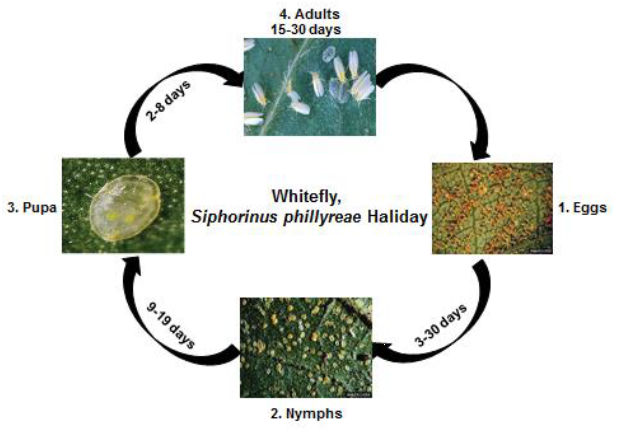
Shot hole borer
Biology:
- Eggs are oval or round, shiny and iridescent white.
- Larvae are white and legless, and can be up to 4 mm long.
- Adult is about 2-3 mm long, black to reddish-brown, and cigar shaped. They have a short, stubbed head capsule, with chewing mouthparts. Male adults do not fly. Two generations per year.
Damage symptoms:
- Adult females bore into the basal part of the stem and roots. Causes Small shot holes on roots, main trunk, wilting and finally leads to death of the tree
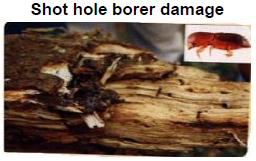
Favourable conditions:
- They survive in temperatures ranging from -26 to 15°C. The flight activity is greatest late afternoon or early evening and the beetles usually fly at or below 15 ft .
Life cycle:
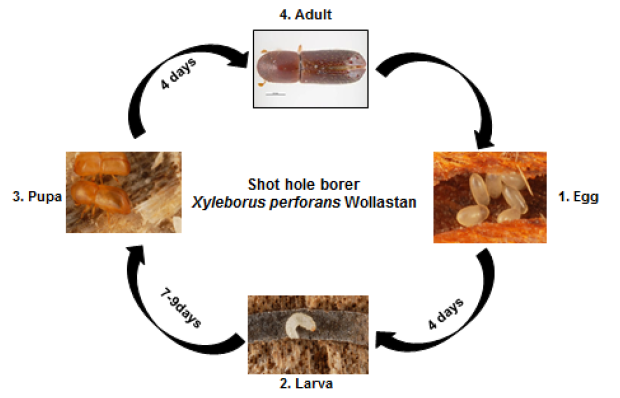
Natural enemies of shot hole borer:
Parasitoids: Trichogramma, Tetrastichus spp., Telenomus spp., Chelonus blackburni, Carcelia spp. Campoletis chlorideae, Bracon spp.
Predators: Chrysoperla sp. rove beetles, spiders, parasitic wasp, coccinellids, robber fly, dragonfly, Beduviid bug (Geocoris sp.), praying mantis, fire ants, pentatomid bug (Eocanthecona fucellata), earwigs, ground beetles, common mynah, king crow,
Thrips
Biology:
- The adults are minute, slender, soft bodied insects with heavily fringed wings, blackish brown with yellowish wings and measure 1.4 mm long. Scirtothrips dorsalis adult is straw yellow in colour. The nymphs are minute yellowish brown in colour.
- Female lays on an average 50 dirty white bean-shaped eggs on the under surface of leaves.
- The incubation period is 3-8 days. Newly hatched nymphs are reddish and turn yellowish brown as they grow.
- Pupal period lasts 2-5 days
Damage symptoms:
- Both nymphs and adults feed on the underside of the leaves by rasping the surface and sucking the oozing cell-sap.
- Leaf tip turn brown and get curled, drying and shedding of flowers and scab on fruits which will reduce the market value.

Favourable condition:
- · The incidence of this pest is mainly seen from July to October with the peak period in September.
Life cycle:

Natural enemies of thrips:
- Parasitoids: Ceranisus menes
- Predators: Syrphid fly, minute pirate bug, praying mantis, predatory thrips, damsel bug, lace wing, coccinellid, spider etc.
Tailed mealy bug
Biology:
- The female laid eggs in groups which lay beneath the body in a loose ovisac of waxy fibers.
- Fecundity (egg number) ranged from 109 to 185 per generation.
- The oviposition period lasted 20-29 days.
- The incubation period lasted about 3-4 hours.
- Female and male nymphs molted 3 and 4 times, respectively, and the development period varied from 26-47 and 31-57 days, respectively.
- Longevity of the adult female was 36-53 days and for the male, 1-3 days.
Damage symptoms:
- Premature dropping of fruit.

Favourable conditions:
- Moist and warm conditions are favourable.
Life cycle:
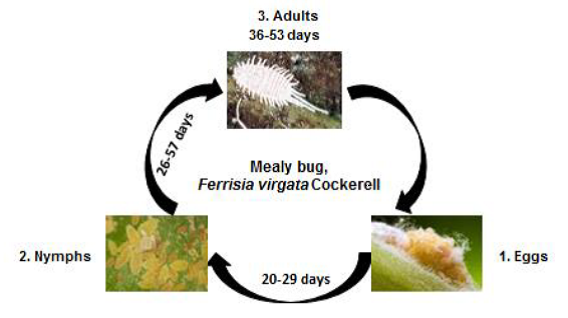
Natural enemies of mealy bug:
Predators: Menochilus sexmaculatus,Rodolia fumida, Cryptolaemus montrozieri
Aphid
Biology:
- Eggs: Eggs hatch after one or two days. Young aphids, called nymphs.
- Nymph: Oval or slightly elongated, reddish brown with six segmented antennae
- Adult: Small yellowish green typically colonizing the upper sides of mature leaves of pomegranate, concentrated along the midribs and around the leaf margins; also found on flowers and, rarely, fruits. Aphids reproduce in two ways: by laying eggs and laying live young, which birth process is depends on environmental conditions and the availability of food. When food is plentiful, aphids give birth to live young. Populations develop quickly as this pest has many young, a short life span and pre-adult insects can also give birth.
Damage symptoms:
- Nymphs and adults suck the sap from leaves, shoots and fruits
- Yellowing of leaves
- Wilting of terminal shoots.
<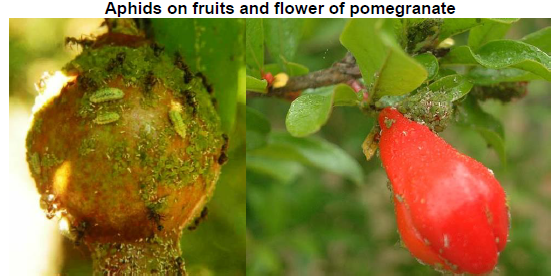
Life cycle:
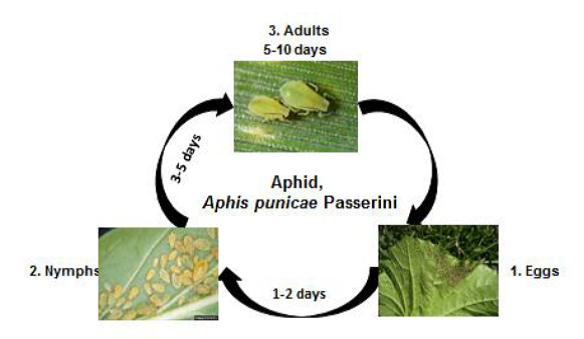
Natural enemies of aphids:
Predators: Parasitic wasp, Chrysoperla sp., ladybird beetle, predatory mite, syrphid fly etc.
IPM for Pomegranate
To know the IPM practices for Pomegranate, click here.
Source : NIPHM, Directorate of Plant Protection, Quarantine & Storage
Last Modified : 3/30/2020
This topic covers information about Description of...
This topic covers information about Walnut Insect...
This topic provides information about Cherry- Inse...
This topic covers information about Fig insect pe...
